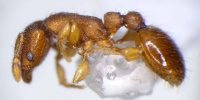Vollenhovia xingjun
| Vollenhovia xingjun | |
|---|---|

| |
| Scientific classification | |
| Kingdom: | Animalia |
| Phylum: | Arthropoda |
| Class: | Insecta |
| Order: | Hymenoptera |
| Family: | Formicidae |
| Subfamily: | Myrmicinae |
| Tribe: | Crematogastrini |
| Genus: | Vollenhovia |
| Species: | V. xingjun |
| Binomial name | |
| Vollenhovia xingjun Terayama, 2009 | |
This species produces ergatoid females and is one of the more common species in this genus in Taiwan. (Terayama 2009)
Identification
Terayama (2009) - This species most resembles Vollenhovia benzai, recorded in southern part of Japan by the low subpetiolar process and the densely punctate promesonotal dorsum without a longitudinal smooth band. However, it is separated from the latter by the much larger thin lamellar wall of subpetiolar process.
Some specimens have very weak triangular propodeal teeth.
Distribution
Distribution based on Regional Taxon Lists
Oriental Region: Taiwan (type locality).
Distribution based on AntMaps
Distribution based on AntWeb specimens
Check data from AntWeb
Countries Occupied
| Number of countries occupied by this species based on AntWiki Regional Taxon Lists. In general, fewer countries occupied indicates a narrower range, while more countries indicates a more widespread species. |

|
Estimated Abundance
| Relative abundance based on number of AntMaps records per species (this species within the purple bar). Fewer records (to the left) indicates a less abundant/encountered species while more records (to the right) indicates more abundant/encountered species. |

|
Biology
Castes
Nomenclature
The following information is derived from Barry Bolton's Online Catalogue of the Ants of the World.
- xingjun. Vollenhovia xingjun Terayama, 2009: 149, fig. 205 (w. ergatoid q.) TAIWAN.
Unless otherwise noted the text for the remainder of this section is reported from the publication that includes the original description.
Description
Worker
HL 0.55, HW 0.48, SL 0.30, WL 0.68, PL 0.20, PH 0.30, DPW 0.18, PPL 0.20, PPH 0.20, PPW 0.20, TL 2.4.
Head punctate, 1.16 times as long as wide, with shallowly concave posterior margin. CI = 86, SI = 63, eye 0.13 mm in diameter. Promesonotum densely punctate, with almost straight dorsal margin in profile; metanotal groove indistinct; posterodorsal corner of propodeum forming an angle. Petiole higher than long, with weakly convex dorsal margin; subpetiolar process low, its thin lamellar wall longer than high. Postpetiole as long as high, with convex dorsal and ventral margins. Gaster smooth and shining.
Color. Body yellowish brown, frons without a large brown spot, antenna and legs yellow.
Type Material
Holotype. Worker, Nanshanxi, Nanfen-Cun, Nantou Pref., 21.viii.1987, S. Kubota leg. Paratypes. 4w, same data as the holotype; 28w, 1 ergatoid female, Hueisenlinchan, Shinsheng-Cun, Nantou Pref., 28.vii.-2.viii.1988; 1w, Meizilin, Huchu-Cun, Nantou Pref., 28.vii.-2.vii.1988; 1w, Wushe, Nantou Pref., 5.viii.1982, M. Terayama leg.; 11w, 1 ergatoid female, Puli, Nantou Pref., 20.viii.1987, M. Terayama leg. The holotype is deposited in the collection of NIAES, and paratypes are in NSMT and TARI.
Etymology
The specific epithet is the Chinese noun Xingjun, which is the name of a Taiwanese goddess.
References
References based on Global Ant Biodiversity Informatics
- Guénard B., and R. R. Dunn. 2012. A checklist of the ants of China. Zootaxa 3558: 1-77.
- Terayama M. 2009. A synopsis of the family Formicidae of Taiwan (Insecta: Hymenoptera). Research Bulletin of Kanto Gakuen University. Liberal Arts 17:81-266.
- Terayama Mamoru. 2009. A synopsis of the family Formicidae of Taiwan (Insecta, Hymenoptera). The Research Bulletin of Kanto Gakuen University 17: 81-266.
- Terayama, M. 2009. A synopsis of the family Formicidae of Taiwan (Insecta; Hymenoptera). The Research Bulletin of Kanto Gakuen University 17: 81-266.

